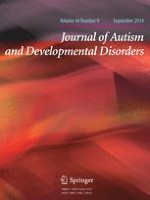01-09-2014 | Brief Report
Brief Report: Visual Acuity in Children with Autism Spectrum Disorders
Gepubliceerd in: Journal of Autism and Developmental Disorders | Uitgave 9/2014
Log in om toegang te krijgenAbstract
Recently, there has been heightened interest in suggestions of enhanced visual acuity in autism spectrum disorders (ASD) which was sparked by evidence that was later accepted to be methodologically flawed. However, a recent study that claimed children with ASD have enhanced visual acuity (Brosnan et al. in J Autism Dev Disord 42:2491–2497, 2012) repeated a critical methodological flaw by using an inappropriate viewing distance for a computerised acuity test, placing the findings in doubt. We examined visual acuity in 31 children with ASD and 33 controls using the 2 m 2000 Series Revised Early Treatment Diabetic Retinopathy Study chart placed at twice the conventional distance to better evaluate possible enhanced acuity. Children with ASD did not demonstrate superior acuity. The current findings strengthen the argument that reports of enhanced acuity in ASD are due to methodological flaws and challenges the reported association between visual acuity and systemising type behaviours.
